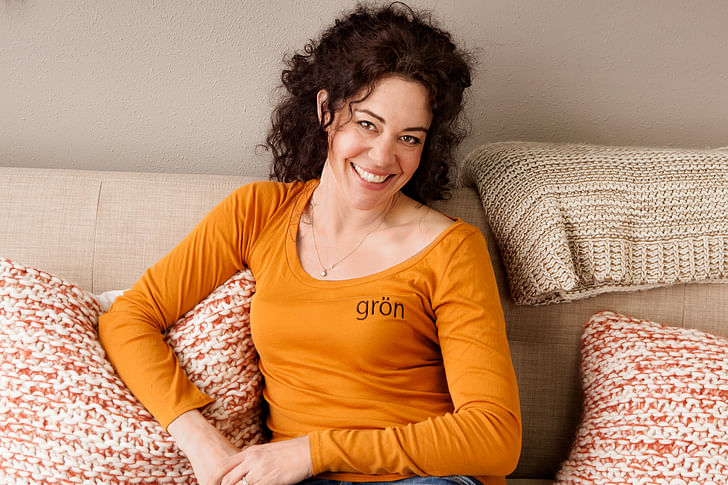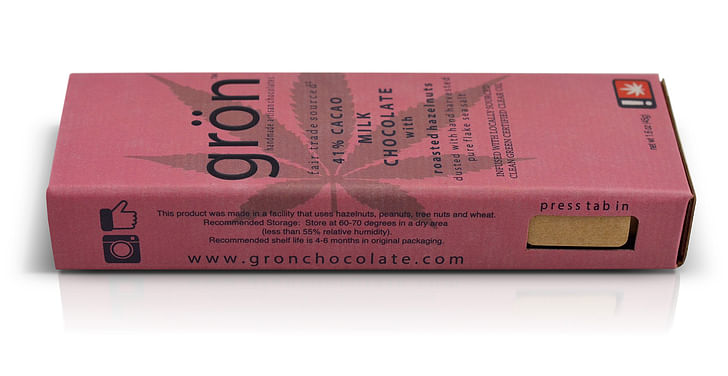

In 2015, Oregon joined Colorado, Washington and Alaska in being one of a handful of states to legalize the use of recreational marijuana. Along for the ride was Christine Smith, founder of Grön, a cannabis-infused fair trade chocolate company.
For this installment of Working out of the Box, our series on architects with alternative career paths, we talk with the architect-turned-weed-chocolatier about her transition into the burgeoning marijuana industry and how her architectural prowess allowed her to sail right through the growing (no pun intended!) industry.
Where did you study architecture?
I studied architecture at the University of Texas in Austin. I did the five year program getting my Bachelor's of Science.
At what point in your life did you decide to pursue architecture?
That's a good question. I think from an early age art, science, and math were really what I was drawn to in school. I think it was probably by high school that I knew it was something I wanted to pursue but I ended up starting out in civil engineering in college and hated it. Then, I actually went the other extreme and decided interior design, my second semester my first year, and then ended up in the architecture program my second year. So, I sort of transitioned through a variety of topics, all within the same realm, before I really landed where I belong.
What was your post-graduate experience in the industry?
I worked in Austin for a year and then I decided to move out West and come out to Oregon in 1999. I was recruited by a firm out here, Mackenzie, and started working for them. I started as an intern and transitioned my way up to a junior partner, stockholder position, before I transitioned out.

When did you decide to stop pursuing architecture and why?
I didn't actually choose to stop, it kind of chose me. Honestly! I was happily practicing architecture and really loved what I did. I was at a great company and was very happy. I was doing a lot of project and people management and I just sort of felt like a little bit of my creative side was not being fulfilled. I didn't even know I was doing it really but my husband owned a dispensary at the time and I wasn't real happy with the products that were out there in the market. I started playing around with graphic design just as a side hobby and, then, I had to create something lovely that could fit into my packaging. So, it was really kind of a love hobby of creation between chocolate, design, graphic design, developing the brand and I did it all from scratch.
The transition was really seamless and it wasn't a forced transition or an intent to leave the industry—it just kind of morphed into something else. I was kind of doing both, just tinkering around with Grön on the side and then in 2015, I really had to make a decision because it wasn't practical to be doing both. The transition was really seamless and it wasn't a forced transition or an intent to leave the industrySo, I left my company, and I also had just had a baby so I left my architecture company with a 6-month-old and decided I was going to stay at home for a while. I worked contract so I did some contract work—land-use planning work for Verizon Wireless—which was great and on my own schedule. I then pursued Grön and it grew into its own beast and, now, I have 18 employees and we're making 50,000 chocolate bars a month.

So in 2015, that is when Oregon legalized recreational marijuana use?
Yes. The ballot measure was passed in 2015 for recreational and it took about shy of two years for that to actually be implemented so there was a lot of processes going on. January 2017, just a few months ago, is when it actually all became fully legal and controlled by the OLCC. Up until that point, it was all under the medical program and was still legal but not fully legal, recreationally. The ballot measure had been passed prior and in 2016 they allowed limited recreational sales under the medical program so we were able to operate pretty successfully in the grey period while they worked out the kinks in the recreational system.
And so did the passing of this ballot contribute you taking Grön on as a full-time project?
Absolutely! That is really where the market is going We pay for all the things a normal business does and that was really hard to do under the medical systemand I wasn't really fully comfortable without having all the regulations and state protections that are allowed through a recreational system like that. It is very regulated. We have insurance. We pay for all the things a normal business does and that was really hard to do under the medical system because it just was not recognized by the state and so it was hard for mainstream industries to feel comfortable getting involved. Now, we can operate like a real business. Direct deposit, you know, all these basic things before, were really hard to do when you are operating everything off cash like 20 dollar bills.

Just to backtrack for a second, can you describe your current company and profession?
Grön Chocolate is the name of the company I own and we were established in 2015 here in Oregon, officially. We make cannabis-infused fair trade chocolates. The company now employs 18 people and we offer full-benefits and paid time-off and all the great stuff that normal businesses should do. We partner with a lot of local businesses that share our values and sustainability. All our packaging is child-resistant and 100% bio-degradable and really, it's just a great product. All our cannabis is clean green certified on a farm that we own so it really is a farm-to-chocolate experience. We are able to control and guarantee that there are not pesticides and that we know what is going into this and having farm-to-table be that bar.
You know, the name simply means green in Swedish. I studied architecture in Denmark for a year and when I created the company, I was looking for a name that meant something to me and would be an iconic chocolate name. I was just brainstorming and searching and landed on a look through Scandinavian words—Swedish, Danish words—because I love Scandinavian architecture and design. And Grön is just a neat word and that is one of the things we get asked the most, is how to say it. But it has become pretty fun. But, that is the background where it came from. I created it in a day. You know, a lot of this, it wasn't a marketing team of 40 people creating a thing. It really came about organically.
So, a year ago, it was me making the chocolate, as the chocolatier, and a part-time hand wrapping bars. Now, we've got 7 chocolatiers and a staff of packing crew and logistics that work on all the tracking systems of getting product out. We work directly with a lab that comes to our facility almost every day to test every batch of product that goes out. Oregon has the most regulated testing in the nation, probably in the world, so we are really proud of what we are doing and acting as leaders of that community.


Did your interest in Scandinavian architecture influence the packaging and design of the product?
Definitely, and that is one of the things we've tried really hard to do with the design of the product and our brand itself. It's clean. It's simple. It's true to what we stand for as far as sustainability, honesty, transparency, and that's what we've tried to stay true to with our brand, our packaging and everything we do.
What skills did you gain from architecture school, or working in the industry, that have contributed to your success in your current career?
You know, it's funny you ask that. So, the recreational system came about in January. I think critical to our success was my ability to be familiar and comfortable with reading rules and having worked with codes for soooooooo longSince October 2016, the state changed a bunch of their testing rules and implemented a bunch of new laws and regulations that were very very difficult for the industry to overcome but we sailed right through it and were very prepared. We were the first product, and the first brand, to actually go through all the process validation and be back on shelves immediately. I think critical to our success was my ability to be familiar and comfortable with reading rules and having worked with codes for soooooooo long—just being really comfortable within that and with project management and coordinating so many different skills. We were able to sail right through it and I think we probably did that better than any other business in Oregon and I am really proud of that and I have to say, that is completely attributed to working in architecture for so long.

Do you have any interest in retuning to architecture?
I don't know. I am still licensed and I use my license for our own—you know, I'm designing our own buildings and I'm doing our own permitting. I completely have every intent to keep my license active and to stay active in the industry. I am not giving up being an architect and I am dabbling in it for fun in a way that is a lot more enjoyable than where it grew working in a large commercial firm doing people management. So, if I were to go back into doing architecture one day, it would probably be more on the creative side. I might dabble in some residential. Do something different! I think I have a lot more confidence in having switched careers and going into this field now, I think I would go back to architecture with some different skills that would benefit.I am not giving up being an architect and I am dabbling in it for fun in a way that is a lot more enjoyable than where it grew working in a large commercial firm
Honestly, in so many ways, I think this happens a lot in commercial firms, primarily—maybe, I don't know because that is really where I have spent most of my time. Anyways, you end up doing more management—people management, construction management, product management. So little of your time in architecture, as you grow, is less and less in design and far more in management and I kind of felt like I lost my nerve, or ability, or even know-how to really design or even think like a designer and think creatively. I feel like, in this career, I've been pushed into a situation where I've had to make really creative decisions by myself and be confident with those decisions. I think before when I was in a large firm, there were so many people to bounce ideas off of that I grew really comfortable with that and not as confident in my own abilities. So I think I would come back into architecture with a level of confidence with design and creativity that I probably left the field not having.
1 Comment
Architecture, marijuana, and chocolate! I think i'm in love.
Block this user
Are you sure you want to block this user and hide all related comments throughout the site?
Archinect
This is your first comment on Archinect. Your comment will be visible once approved.